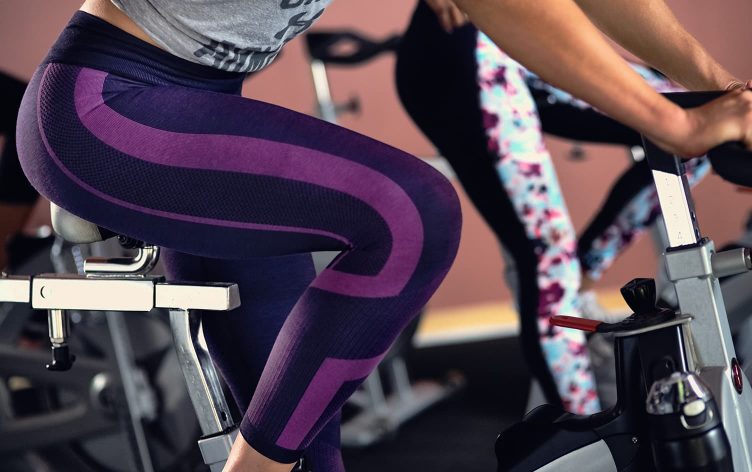
There’s this nasty rumor that exercise won’t help you lose weight. The more you work out, the more you’ll eat because, well, you need to rebuild those muscles you just broke down. And for some folks that means they deserve a little something extra for the hard effort — like that yummy, pimped-out burrito you ordered on Seamless.
While this scenario might sound familiar (hello, Tuesday night), new science suggests that exercise does not necessarily increase your appetite or make you crave junk food. Conversely, if you skip the run or spin class and choose to cut calories instead, you might end up binge-eating later, reports the new study from Loughborough University published this spring in Medicine & Science in Sports & Exercise.
“There’s a big debate at the moment about the extent to which the increased prevalence of overweight and obesity in the world might be due to overeating versus a lack of exercise,” says lead study author David Stensel, PhD, a professor of exercise metabolism at the School of Sport, Exercise and Health Sciences at Loughborough University in the UK. “We set out to compare men and women’s responses to two particular hormones, ghrelin, which stimulates appetite, and peptide YY, which suppresses appetite, in two separate experiments.”
In the first experiment, Stensel and his team observed 12 healthy college-age women who participated in three nine-hour trials, each a week apart. Each trial took place from 8 a.m. to 5 p.m. in a lab, where subjects could pass the time working at a desk, playing computer games or watching TV. All subjects were fed two standardized meals (a tuna sandwich with mayonnaise, potato chips, a chocolate muffin and a green apple) within two hours (breakfast) and five hours (lunch) into the experiment. At hour eight (dinner), subjects then had access to a buffet — including milk, cereals, breads, ham, cheese, butter, cookies, chocolate and fruit — where they could eat as much as they wanted. Subjects rated their appetite throughout the day and gave blood samples so that scientists could measure the two hormones.
The three trials were divided into three categories (control, exercise-induced and food-restricted) and occurred randomly and simultaneously. The control subjects saw no changes to the above laid-out plan. However, when exercise was introduced, the same subjects were asked to run at a high intensity for 90 minutes, burning 830 calories on average before breakfast. All meal options remained the same as in the control trial. Lastly, in the food restriction trial, scientists reduced breakfast and lunch by 415 calories total (half the amount burned during the exercise trial) to create an energy deficit through diet. Then scientists repeated this exact experiment (albeit a bit shorter) with both male and female subjects.
The results of the experiments, which were the same for both men and women, suggest that exercise curbs cravings more than a calorie-restricted diet. “When we reduced people’s food intake at breakfast and lunch, the hunger hormone ghrelin stayed very high, whereas in the exercise trial, the ghrelin remained low,” Stensel explains. “And we found the hunger-suppressant hormone, peptide YY, stayed high in the exercise trial and low in the food deficit trial throughout the day. We also found that in the food deficit trial, people expressed feeling hungrier throughout the day whereas in the exercise trial, their perception of appetite was similar to the control trial.”
When it came time for dinner in the food-restriction trial, subjects tended to go hog wild at the buffet, consuming about 940 calories on average. The same subjects responded differently during the control and exercise trials, eating 610 and 660 calories on average, respectively, at the buffet. “That 300-calorie difference is a big jump,” says Stensel, who admits further research is needed to understand the mechanisms of why this is happening.
One reason could be that when you’re exercising vigorously, Stensel speculates, “the body is prioritizing sending blood to the muscles and that might interfere with hormone release, like ghrelin, which is secreted from cells in the stomach.” Basically, if less blood is pumping through the stomach, then it can’t carry ghrelin out, which might justify its temporary suppression. “That wouldn’t explain peptide YY, so that one is still a bit of a mystery,” he adds.
While this new study doesn’t have all the answers, other researchers agree it does support a very important point. “If you’re trying to lose weight, diet and exercise is still the best approach,” says Joy Dubost, PhD, a registered dietitian based in Washington, D.C., who did not work on this study. “The exercise component is so critical.”
She added: “You can only go down in calories so low. You may lose weight initially, but when you hit a plateau in weight loss, you can’t continue to restrict calories. Also, if you’re constantly hungry, then you will likely come off the diet. We know through this study that when you add exercise to a balanced, healthy diet, it really helps with weight management and weight loss. This study also dispels the myth that when you work out a lot, it increases hunger cravings.”
The bottom line: Exercise doesn’t trigger you to eat more, but dieting alone might. So if you really want to slim down, it would sooner benefit you to hit the gym than, say, eliminate entire food groups. The good news is you don’t need to run for 90 minutes to get the best results. As little as 30 minutes of vigorous exercise (that means any activity that gets your heart pumping, like running) may help keep ghrelin, in check, says Stensel, who is currently overseeing two additional studies in this area.

